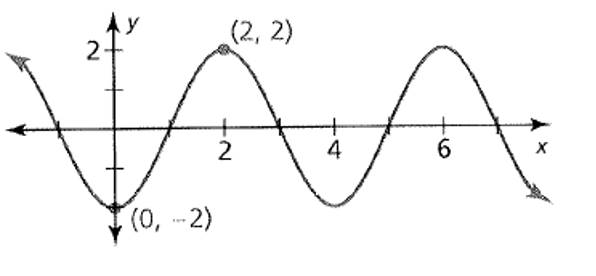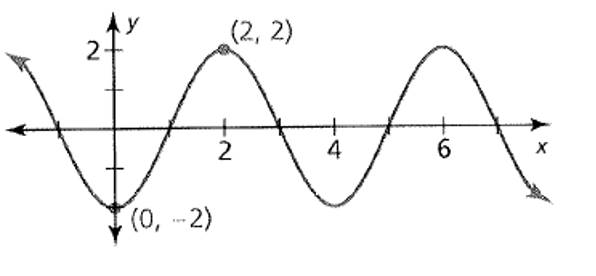
Concept explainers
To find: A function for given sinusoidal graph.
Answer to Problem 15E
Explanation of Solution
Given information:
A sinusoidal graph is given as below.

Calculation:
A sinusoidal graph is given as below.

Step 1: Find the maximum and minimum value.
From above graph, maximum value is
Step 2: Identify the vertical shift
The value of
Step 3: Decide whether graph should be modeled as sine or cosine function.
At
Step 4: Find the amplitude and period.
Since the graph repeats itself every
Step
Hence, desired function of the given graph is
Chapter 9 Solutions
BIG IDEAS MATH Algebra 2: Common Core Student Edition 2015
- 3) What is the universal set that contains all possible integers from 1 to 8 inclusive? Choose one. a) A = {1, 1.5, 2, 2.5, 3, 3.5, 4, 4.5, 5, 5.5, 6, 6.5, 7, 7.5, 8} b) B={-1,0,1,2,3,4,5,6,7,8} c) C={1,2,3,4,5,6,7,8} d) D = {0,1,2,3,4,5,6,7,8}arrow_forward5) 8.4 6.3 ?arrow_forwardWendy is looking over some data regarding the strength, measured in Pascals (Pa), of some rope and how the strength relates to the number of woven strands in the rope. The data are represented by the exponential function f(x) = 2x, where x is the number of woven strands. Explain how she can convert this equation to a logarithmic function when strength is 256 Pascals. Please type out answerarrow_forward
- Harrison and Sherrie are making decisions about their bank accounts. Harrison wants to deposit $200 as a principal amount, with an interest of 2% compounded quarterly. Sherrie wants to deposit $200 as the principal amount, with an interest of 4% compounded monthly. Explain which method results in more money after 2 years. Show all work. Please type out answerarrow_forwardMike is working on solving the exponential equation 37x = 12; however, he is not quite sure where to start. Solve the equation and use complete sentences to describe the steps to solve. Hint: Use the change of base formula: log y = log y log barrow_forwardUsing logarithmic properties, what is the solution to log3(y + 5) + log36 = log366? Show all necessary steps.arrow_forward
- 4.2 Comparing Linear and Exponential Change 7) Money is added to (and never removed from) two different savings accounts (Account A and Account B) at the start of each month according to different mathematical rules. Each savings account had $500 in it last month and has $540 in it this month. (a) Assume the money in Account A is growing linearly: How much money will be in the account next month? How much money was in the account two months ago? How long will it take for the account to have at least $2500? Write an equation relating the amount of money in the account and the number of months from now. Clearly define the meaning of each variable in your equation, and interpret the meaning of each constant in your equation. (b) Assume the money in Account B is growing exponentially. How much money will be in the account next month? How much money was in the account two months ago? How long will it take for the account to have at least $2500? Write an equation relating the amount of money…arrow_forwardWhich of the following is the solution to the equation 25(z − 2) = 125? - Oz = 5.5 Oz = 3.5 Oz = -2.5 z = -0.5arrow_forwardAnalyze the graph below to identify the key features of the logarithmic function. 2 0 2 6 8 10 12 2 The x-intercept is y = 7, and the graph approaches a vertical asymptote at y = 6. The x-intercept is x = 7, and the graph approaches a vertical asymptote at x = 6. The x-intercept is y = -7, and the graph approaches a vertical asymptote at y = −6. The x-intercept is x = -7, and the graph approaches a vertical asymptote at x = −6.arrow_forward
- Compare the graphs below of the logarithmic functions. Write the equation to represent g(x). 2 f(x) = log(x) 2 g(x) -6 -4 -2 ° 2 0 4 6 8 -2 - 4 g(x) = log(x) - g(x) = log(x) + 4 g(x) = log(x+4) g(x) = log(x-4) -2 -4 -6arrow_forwardWhich of the following represents the graph of f(x)=3x-2? 3 2 • 6 3 2 0- 0- • 3 2 0 -2 3arrow_forward2) Suppose you start with $60 and increase this amount by 15%. Since 15% of $60 is $9, that means you increase your $60 by $9, so you now have $69. Notice that we did this calculation in two steps: first we multiplied $60 by 0.15 to find 15% of $60, then we added this amount to our original $60. Explain why it makes sense that increasing $60 by 15% can also be accomplished in one step by multiplying $60 times 1.15. 3) Suppose you have $60 and want to decrease this amount by 15%. Since 15% of $60 is $9, that means you will decrease your $60 by $9, so you now have $51. Notice that we did this calculation in two steps: first we multiplied $60 by 0.15 to find 15% of $60, then we subtracted this amount from our original $60. Explain why it makes sense that decreasing $60 by 15% can also be accomplished in one step by multiplying $60 times 0.85. 4) In the Read and Study section, we noted that the population in Colony B is increasing each year by 25%. Which other colony in the Class Activity…arrow_forward
 Algebra and Trigonometry (6th Edition)AlgebraISBN:9780134463216Author:Robert F. BlitzerPublisher:PEARSON
Algebra and Trigonometry (6th Edition)AlgebraISBN:9780134463216Author:Robert F. BlitzerPublisher:PEARSON Contemporary Abstract AlgebraAlgebraISBN:9781305657960Author:Joseph GallianPublisher:Cengage Learning
Contemporary Abstract AlgebraAlgebraISBN:9781305657960Author:Joseph GallianPublisher:Cengage Learning Linear Algebra: A Modern IntroductionAlgebraISBN:9781285463247Author:David PoolePublisher:Cengage Learning
Linear Algebra: A Modern IntroductionAlgebraISBN:9781285463247Author:David PoolePublisher:Cengage Learning Algebra And Trigonometry (11th Edition)AlgebraISBN:9780135163078Author:Michael SullivanPublisher:PEARSON
Algebra And Trigonometry (11th Edition)AlgebraISBN:9780135163078Author:Michael SullivanPublisher:PEARSON Introduction to Linear Algebra, Fifth EditionAlgebraISBN:9780980232776Author:Gilbert StrangPublisher:Wellesley-Cambridge Press
Introduction to Linear Algebra, Fifth EditionAlgebraISBN:9780980232776Author:Gilbert StrangPublisher:Wellesley-Cambridge Press College Algebra (Collegiate Math)AlgebraISBN:9780077836344Author:Julie Miller, Donna GerkenPublisher:McGraw-Hill Education
College Algebra (Collegiate Math)AlgebraISBN:9780077836344Author:Julie Miller, Donna GerkenPublisher:McGraw-Hill Education





